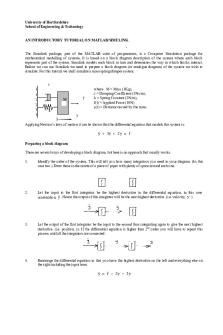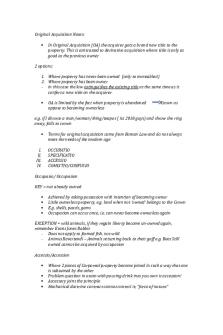Tutorial one - Introductory questions to the law of property. PDF

| Title | Tutorial one - Introductory questions to the law of property. |
|---|---|
| Course | Property Law |
| Institution | Edinburgh Napier University |
| Pages | 2 |
| File Size | 75.5 KB |
| File Type | |
| Total Downloads | 15 |
| Total Views | 141 |
Summary
Introductory questions to the law of property....
Description
Property Law – Tutorial One
1.
Look at the case of Burnett’s Trustee v Grainger 2004 SLT 513. On what basis did the pursuer claim that he had a right to the property in question? The pursuer argued that the intention of the Bankruptcy (Scotland) Act 1985 was not to allow for property held by a debtor to be considered as part of the debtor’s whole estate by a trustee for the benefit of the creditor. Grainger had a personal right to the money that they paid for the flat, making them creditors and would make their claim to the trustee. Could also make a claim against their solicitor fee’s due to negligence.
2.
Which prior case, discussed in Burnett, resulted in the purchasers being held to have the right to heritable property? Sharp v Thomson 1997 S.C. (H.L.) 66
3.
Why were the two cases decided differently? The judgement in the case of Sharp v Thomson was only applicable in the restricted circumstances of a floating charge. Burnett’s Trustee v Grainger did not concern a floating charge. – sellers were a company, receivership rather than bankruptcy. Receiver in Sharp was arguing that the flat which had been sold to the Thomson’s still belonged to the company i.e. could be used by receivers to pay off company’s creditors under the floating charge. Decision strongly criticised afterwards as having not been good law. Floating charge was said to attach to the property of the company at a particular time and the judges said that the company’s property should be given more of an ordinary meaning. Where the company had received a cheque for the property in return for a signed transfer title, HoL said in this situation it would be wrong to say the flat in question was still the company’s property and therefore must be owned by Thomson’s.
4.
What was the charge against the accused in Mackenzie v MacLean 1981 SLT (Sh. Ct.) 40? Why were they acquitted?
Theft, on the grounds that the beer had been abandoned and therefore ownership fell to the crown. The beer was not the property of the accused and had no right to either throw away the beer or sell it to persons in the crowd that had gathered. However, upon judgement the two accused were acquitted due to a lack of wicked intent in their actions.
5.
Outline the operation of the doctrine of specificatio. The doctrine of specification covers situations where a new thing has been created that has different attributes to the things used to create it. The common rule is that the maker of a new thing is its owner....
Similar Free PDFs

Property law repeated questions
- 35 Pages

Law of Property Handout
- 58 Pages

Law of Property Notes
- 29 Pages

Law of property
- 23 Pages

Law of Property Cases
- 18 Pages

Introduction to Property Law (1)
- 6 Pages

Introductory Simulink Tutorial
- 3 Pages

Law of property A notes
- 14 Pages

Property Law
- 11 Pages

TPA Assignment - law of property
- 8 Pages

Property Theory One
- 24 Pages
Popular Institutions
- Tinajero National High School - Annex
- Politeknik Caltex Riau
- Yokohama City University
- SGT University
- University of Al-Qadisiyah
- Divine Word College of Vigan
- Techniek College Rotterdam
- Universidade de Santiago
- Universiti Teknologi MARA Cawangan Johor Kampus Pasir Gudang
- Poltekkes Kemenkes Yogyakarta
- Baguio City National High School
- Colegio san marcos
- preparatoria uno
- Centro de Bachillerato Tecnológico Industrial y de Servicios No. 107
- Dalian Maritime University
- Quang Trung Secondary School
- Colegio Tecnológico en Informática
- Corporación Regional de Educación Superior
- Grupo CEDVA
- Dar Al Uloom University
- Centro de Estudios Preuniversitarios de la Universidad Nacional de Ingeniería
- 上智大学
- Aakash International School, Nuna Majara
- San Felipe Neri Catholic School
- Kang Chiao International School - New Taipei City
- Misamis Occidental National High School
- Institución Educativa Escuela Normal Juan Ladrilleros
- Kolehiyo ng Pantukan
- Batanes State College
- Instituto Continental
- Sekolah Menengah Kejuruan Kesehatan Kaltara (Tarakan)
- Colegio de La Inmaculada Concepcion - Cebu




